How to grow garlic
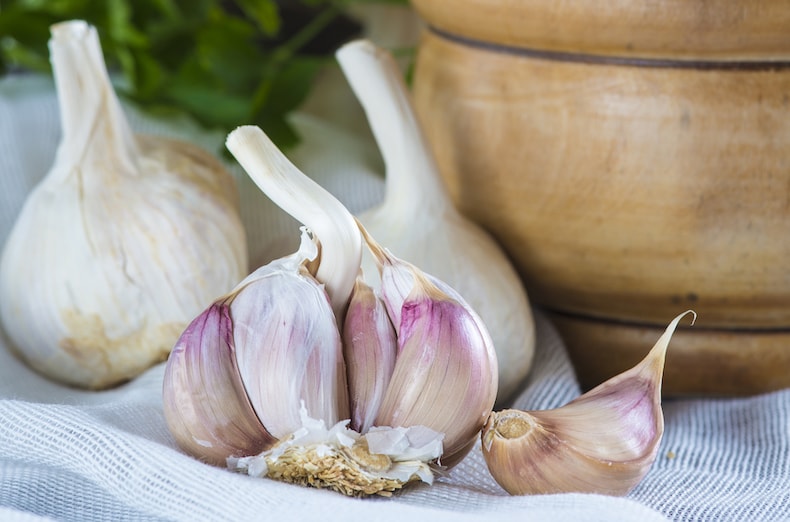
Garlic is easy to grow in containers or the ground
Image: Garlic (Autumn) Kingsland Wight from Thompson & Morgan
Garlic is easy to grow in your garden – it’s fairly low maintenance and doesn’t require much space. It will happily grow in a patio container or pot, if that’s what you have available. Find out how to grow garlic and when is the best time to harvest by reading our guide below.
For the best crop of fat, juicy garlic bulbs, you should buy garlic sets from online plant specialist, rather than from a supermarket. You can plant many varieties outdoors in either spring or autumn. For an interesting twist, try growing it like a herb on a sunny windowsill for its delicately flavoured leaves.
What type of garlic should I choose?
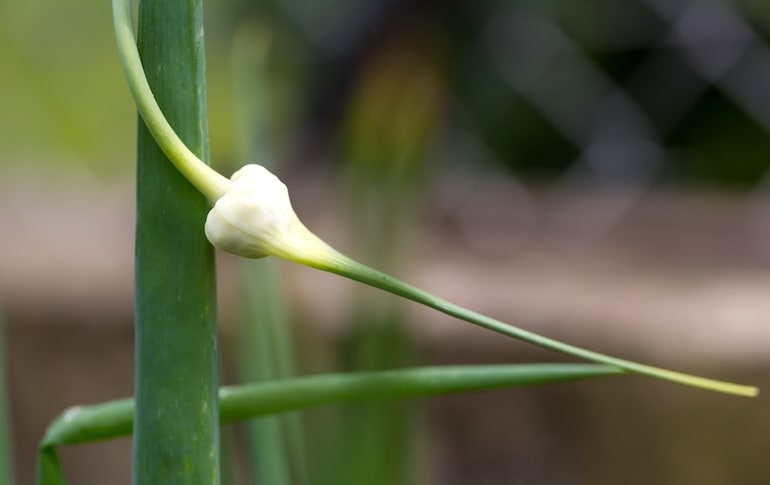
Softneck varieties are best for storing
Image: Shutterstock
There are two main types of garlic: hardneck and softneck varieties.
Hardneck varieties produce an edible flower stem (often called a 'scape'), which can be used in salads and stir fries. These are a great choice if you want to harvest both scapes and bulbs.
Softneck varieties don’t produce the stem, but the bulbs can be stored for longer than their hardneck cousins.
Here are some of the most popular hardneck varieties:
- 'Elephant Garlic' - plant in spring or autumn for large, mild bulbs, ideal for roasting.
- 'Carcassonne Wight' - can be planted in spring or autumn and well suited to the UK.
- 'Extra Early Wight' - an autumn planting variety that is reliable for overwintering and produces one of the earliest crops of garlic available.
These are some of the best softneck varieties:
- Garlic 'Flavor' - produces an elegant bouquet and is planted in spring or autumn.
- 'Picardy Wight’ - has a strong flavour and long storage potential. Spring or autumn.
- 'Germidour' - very reliable with a slightly milder flavour. Spring or autumn planting.
When to plant garlic
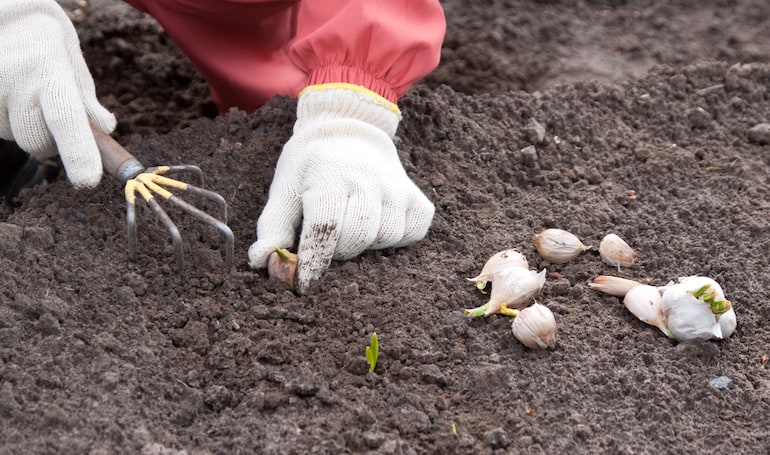
Garlic cloves should be planted narrow end up
Image: Iakov Filimonov/Shutterstock
Garlic cloves are best planted between November and April, although you will generally get a bigger and better crop if you plant in the autumn. In fact, many gardeners swear by planting before Christmas to get the best results.
Garlic bulbs are sold according to their suitability for spring or autumn planting, so check before you plant. Growing garlic from seed isn’t currently possible for home gardeners because viable seed is tricky to produce.
Where to plant garlic
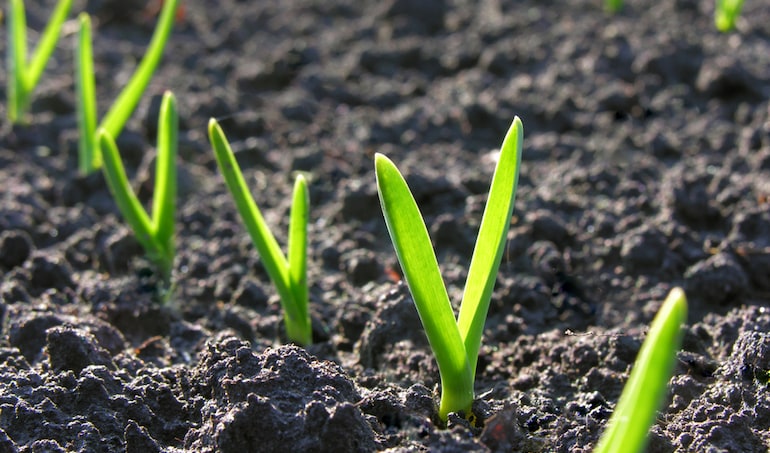
Don't grow garlic in soil that's recently been used for other alliums
Image: yuris/Shutterstock
Garlic shouldn’t be planted in soil that’s recently been used for garlic, or indeed for any other plants from the allium family. So if this is to be a regular crop, you’ll need to plan a rotation system.
When choosing a suitable spot, keep in mind that garlic prefers a position in full sun with well-drained, light soil.
How to grow garlic in the ground?
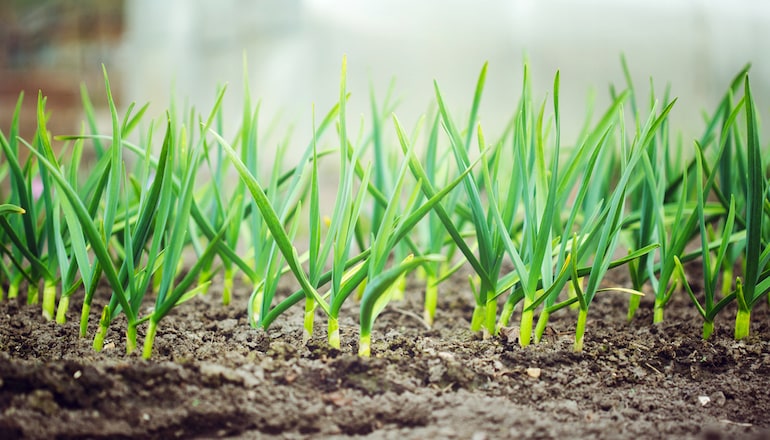
Garlic likes full sun
Image: Yuliya Evstratenko/Shutterstock
Garlic bulbs prefer light, nutrient-rich soil and they don’t tolerate water-logging, so dig in plenty of organic matter such as compost, well-rotted manure or recycled green waste before planting.
- Carefully split the bulb into individual cloves.
- Plant each clove just below the surface of the soil (about 2.5cm deep) with the pointed end facing up. They should be 10-15cm apart.
- For several rows of garlic, space the rows roughly 30cm apart. This will give them plenty of space and help with weeding.
Garlic needs a cold period to grow successfully but, during the winter, if you have heavy clay soil, start your cloves off in module trays. If the ground is too wet, your cloves could rot. Fill the tray with multi-purpose compost and place one clove 2.5cm deep in each module, covering the cloves with more compost afterwards. The trays should be kept in a sheltered position outdoors.
Grown in this way, the garlic can be planted out to its final position in the spring when the cloves have sprouted.
How to grow garlic in containers?
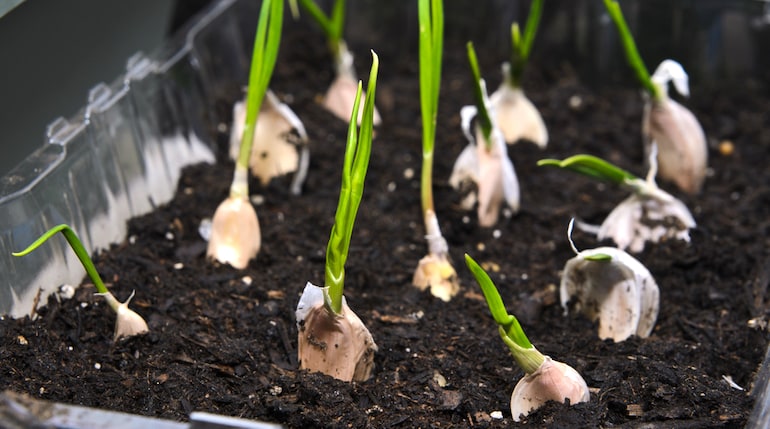
You can easily grow garlic on patios and balconies
Image: JeepFoto/Shutterstock
You don’t need a massive garden to grow garlic; it’s quite happy in containers on a patio or balcony.
- Choose containers at least 20cm in diameter and depth to allow for good root growth.
- Fill your container with multi-purpose compost and incorporate some specialist onion fertiliser.
- Plant each clove at a depth of 2.5cm and space them about 10-15cm apart. Allow space for the bulbs to swell, so don't plant them too close to the container edge.
- Keep the compost moist, especially during dry spells.
You can also grow garlic indoors on a windowsill for its leaves, which have a mild and aromatic flavour and can be added to soups, curries and stir fries. Harvest the leaves as required until the bulb has been exhausted. However, growing garlic indoors isn’t the best method for cultivating good quality bulbs.
How to care for garlic
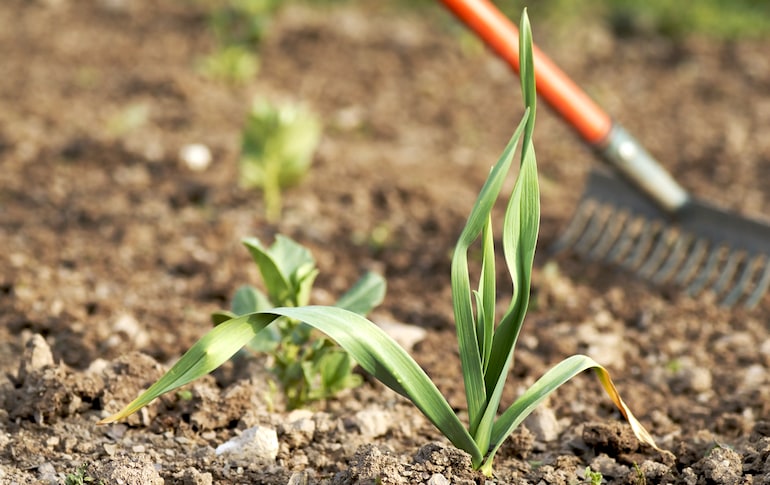
Weed regularly to keep your garlic happy
Image: Swellphotography/Shutterstock
Garlic is not very demanding, but it is vulnerable to birds who love to pull freshly-planted sets out of the ground. It’s a good idea to cover the area with netting or horticultural fleece after planting.
As it doesn’t create much shade, garlic can also get smothered quickly by weeds. Weed regularly to prevent competition for space and nutrients.
You only need to water your garlic during long dry spells. If you notice flowers forming you can remove them or leave them intact; either way, it should not affect the swelling of the bulb.
How and when to harvest garlic
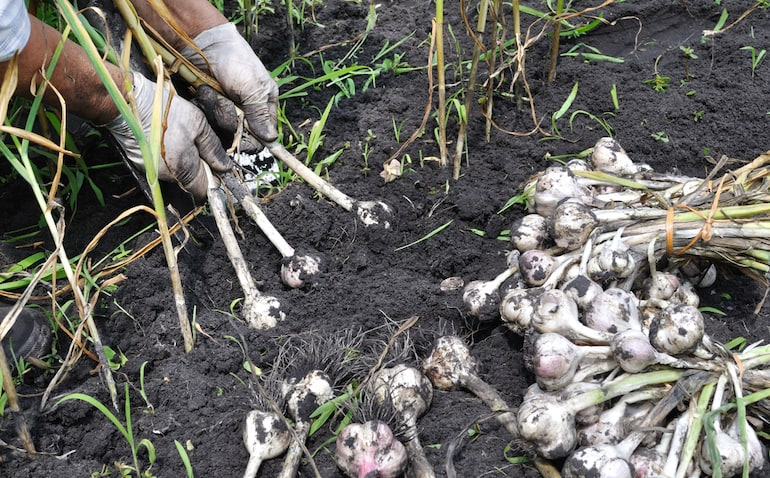
Garlic is usually ready to harvest in early summer
Image: yuris/Shutterstock
Autumn-planted garlic will be ready to harvest in June and July and spring-planted garlic will be ready slightly later. Simply wait until the leaves have started to wither and turn yellow, and then loosen the bulbs from the soil with a trowel.
Be careful not to cut the garlic bulbs with your trowel as this will reduce their storage potential. Also don’t leave the bulbs in the ground too long after the leaves have withered as the bulbs are likely to re-sprout and may rot when stored.
Before storing them, lay the garlic bulbs out somewhere warm and dry. Any dry soil left on the bulbs can be gently brushed off. In good condition, garlic bulbs can be stored for up to three months.
Common garlic problems to watch out for
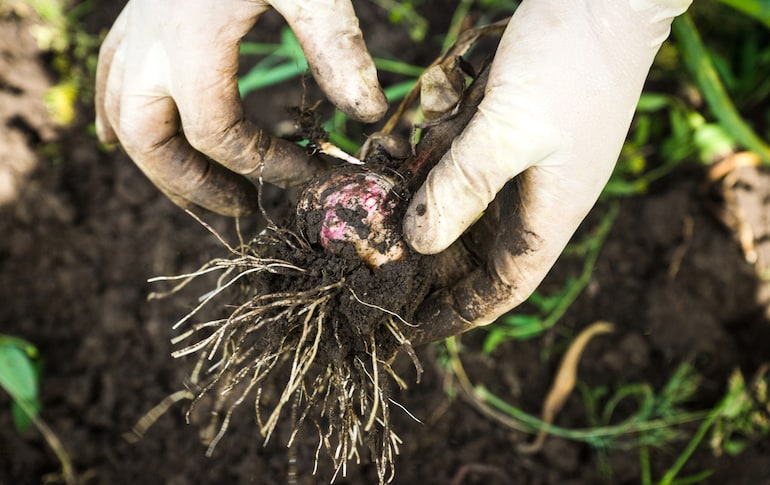
Garlic is fairly low maintenance, but there are two diseases to look out for
Image: Andrew Pustiakin/Shutterstock
Garlic is normally trouble-free, but there are two diseases to watch out for: rust and white rot.
Rust appears as rusty-coloured spots on the leaves. Unfortunately, the only thing you can do is avoid growing garlic in the same place for three years; there’s no cure for rust.
Garlic can also be affected by white rot, which decays the roots and eventually the bulb. Again there is no cure apart from crop rotation.
Top tips for growing garlic
Growing garlic is pretty easy and the results taste unlike anything you’d get in the average supermarket. The main things to remember are:
- Buy garlic bulbs from a reputable garden supplier, not a supermarket.
- Plant before Christmas, if you can.
- Don’t plant in soil that’s recently been used for any allium plants.
- Don’t waterlog the bulbs.
- Weed regularly.
Watch: How to grow garlic in containers video
So that's it in a nutshell, everything you need to know about garlic. Happy growing!
Do you have any tips for growing garlic? We'd love to hear them - head over to our Facebook page and share with our 'grow your own' community. Visit our comprehensive hub page for info and expert advice on growing onions, garlic and shallots.
Sign Up For Exclusive Special Offers




© 2025 Thompson & Morgan. All rights reserved. A division of Branded Garden Products Limited.
Sign up for exclusive offers!



